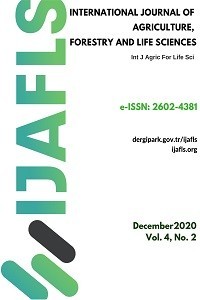The Effects of Different Fertilizer Applications on Yield and Quality of Anise (Pimpinella anisum L.)
The Effects of Different Fertilizer Applications on Yield and Quality of Anise (Pimpinella anisum L.)
anise, Pimpinella anisum, organic fertilization seed yield, essential oil,
___
- Acimovic, M. (2013). The influence of fertilization on yield of caraway, anise and coriander in organic agriculture. Journal of Agricultural Sciences, 58(2), 85-94. https://doi.org/10.2298/JAS1302085A
- Acimovic, M., Dolijanovic, Z., Oljaca, S., Kovacevic, D. and Oljaca, M. (2015). Effect of organic and mineral fertilizers on essential oil content in caraway, anise and coriander fruits. Acta Sci. Pol. Hortorum Cultus, 14(1), 95-103.
- Adiloğlu, A., Açıkgöz, F.E., Adiloğlu, S. and Solmaz, Y. (2015). Akuakültür atığı ve solucan gübresi uygulamalarının salata (lactuca sativa l. var. crispa) bitkisinin verim, bazı bitki besin elementi içeriği ile bazı agronomik özellikleri üzerine etkisi. NKUBAP.00.24.AR.15.11. Final report of the research project. Tekirdağ.
- Baydar, H. (2016). Tıbbi ve aromatik bitkiler bilimi ve teknolojisi (5th ed.). Süleyman Demirel Üniversitesi Yayınları.
- Baydar, H. (2020). Tıbbi ve aromatik bitkiler bilimi ve teknolojisi (8th ed.). Nobel Yayıncılık, Ankara.
- Baytop, T. (1971). Farmakognozi (2nd vol.). İstanbul Üniversitesi Yayınları, İstanbul.
- Besharati-Seidani, A., Jabbari, A. and Yamini, Y. (2005). Headspace solvent microextraction: A very rapid method for identification of volatile components of Iranian Pimpinella anisum seed. Analytica Chimica Acta, 530(1), 155-161. https://doi.org/10.1016/j.aca.2004.09.006
- Ceylan, A. (1987). Tıbbi bitkiler II. Ege Üniversitesi Ziraat Fakültesi Yayınları, İzmir.
- Darzi, M. T., Seyedhadi, M. H. and Rejali, F. (2012). Effects of the application of vermicompost and phosphate solubilizing bacterium on the morphological traits and seed yield of anise (Pimpinella anisum L.). Journal of Medicinal Plants Research, 6(2). https://doi.org/10.5897/JMPR11.949
- Doğan, Ö., Kara, N. and Tonguç, M. (2018). Anason populasyonlarında verim, uçucu yağ oranı ve genetik ilişkilerin araştırılması. Black Sea Journal of Agriculture, 1(4), 110-116.
- Doğramacı, S. and Arabacı, O. (2015). Anason (Pimpinella anisum L.) çeşit ve ekotiplerinin bazı teknolojik özellikleri üzerine organik ve inorganik gübre uygulamalarının etkisi. Adnan Menderes Üniversitesi Ziraat Fakültesi Dergisi, 12(1), 41-47.
- Duran, A., Çetin, Ö., Çelik, M. and Altınordu, F. (2015). The family of Apiaceae in Turkey, updated. 2nd International Conference on Chemical, Biological, and Environmental Sciences (ICCBES’15), Dubai.
- Faravani, M., Salari, B., Heidari, M., Kashki, M. and Gholami, B. (2013). Effects of fertilizer and plant density on yield and quality of anise (Pimpinella anisum L.). Journal of Agricultural Sciences, 58(3), 209-215. https://doi.org/10.2298/JAS1303209F.
- Gözükara, G. (2021). Tahıl yetiştirilen toprakların bazı fiziksel ve kimyasal özelliklerin konumsal dağılımlarının farklı enterpolasyon yöntemi kullanılarak belirlenmesi. Toprak Bilimi ve Bitki Besleme Dergisi, 9(2), 69-78. https://doi.org/10.33409/tbbbd.1004763
- Hemphill, J. and Hemphill, R. (1988). Herbs, Their Cultivation and Usage. Blandford Press.
- Jevdjovic, R. and Maletic, R. (2006). Effects of application of certain types of fertilizers on anise seed yield and quality. Journal of Agricultural Sciences, 51(2), 117-122.
- Karık, Ü. (2020). Türkiye Anason (Pimpinella anisum L.) Genetik Kaynakları ve Yabancı Anason Genotiplerinin Uçucu Yağ Bileşenleri. Anadolu Ege Tarımsal Araştırma Enstitüsü Dergisi, 30(2), 163–178. https://doi.org/10.18615/anadolu.834838
- Khalesro, Sh., Ghalavand, A., Sefidkon, F. and Asharzadeh, A. (2012). The effect of biological and organic inputs on quantity and quality of essential oil and some elements content of anise (Pimpinella anisum L.). Iranian Journal of Medicinal and Aromatic Plants, 27(4), 551-560.
- McCormick, N. (2006). RNA-mediated virus resistance for carrot (Daucus carota var. Sativum) and celery (Apium graveolens var. Dulce), University of Melbourne, Faculty of Food and Land Resources.
- MGM, (2023). Turkish State of Meteorological Service. Climate data. https://www.mgm.gov.tr/ Access Date: 04.01.2023
- Wang, X. J., Luo, Q., Li, T., Meng, P. H., Pu, Y. T., Liu, J. X., Zhang, J., Liu, H., Tan, G. F. and Xiong, A. S. (2022). Origin, evolution, breeding, and omics of Apiaceae: A family of vegetables and medicinal plants. Horticulture Research, 9, uhac076. https://doi.org/10.1093/hr/uhac076
- Yayın Aralığı: Yılda 2 Sayı
- Başlangıç: 2017
- Yayıncı: Volkan OKATAN
Ömer Faruk BİLGİN, Şule Hilal ATTAR, Ebru KAFKAS, Salih KAFKAS
Olive Selection Studies in East Mediterranean Region
Remzi UĞUR, Özkan ALTUN, Muhammet Ali GÜNDEŞLİ
Distribution of Polygonaceae family in Türkiye
Mustafa KESKİN, Zeki SEVEROĞLU
Perception of Food Safety in Fish Consumption: The Case of Antalya Province
Serpil YILMAZ, Celile DÖLEKOĞLU, İbrahim YILMAZ, Erkan GÜMÜŞ, Ali AKAY, Evrim Beyhan ŞEN ŞENSOY
